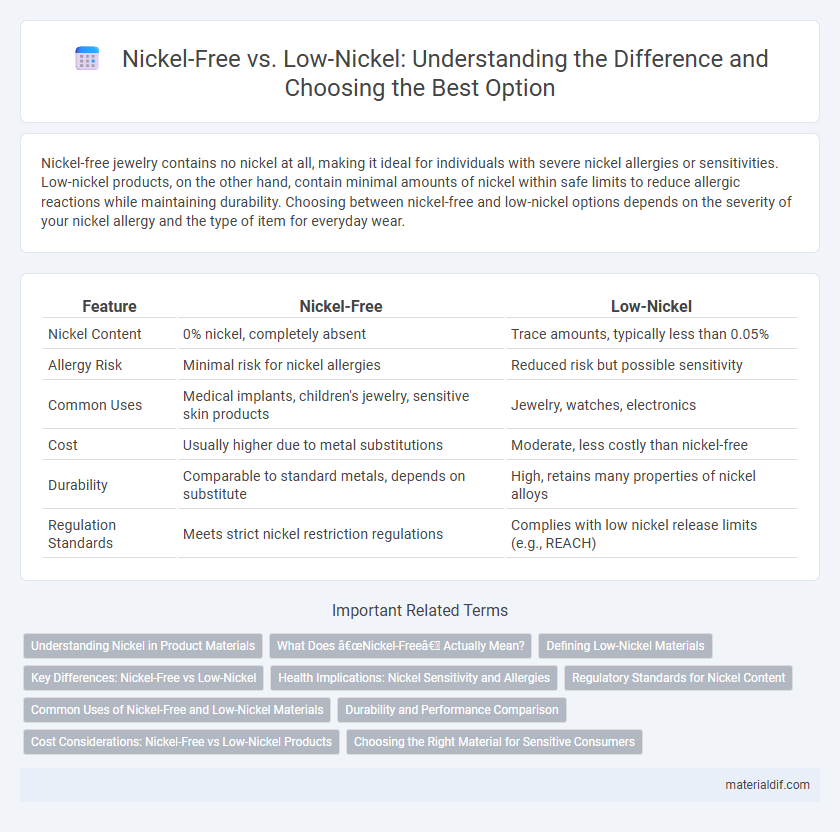Nickel-free jewelry contains no nickel at all, making it ideal for individuals with severe nickel allergies or sensitivities. Low-nickel products, on the other hand, contain minimal amounts of nickel within safe limits to reduce allergic reactions while maintaining durability. Choosing between nickel-free and low-nickel options depends on the severity of your nickel allergy and the type of item for everyday wear.
Table of Comparison
| Feature | Nickel-Free | Low-Nickel |
|---|---|---|
| Nickel Content | 0% nickel, completely absent | Trace amounts, typically less than 0.05% |
| Allergy Risk | Minimal risk for nickel allergies | Reduced risk but possible sensitivity |
| Common Uses | Medical implants, children's jewelry, sensitive skin products | Jewelry, watches, electronics |
| Cost | Usually higher due to metal substitutions | Moderate, less costly than nickel-free |
| Durability | Comparable to standard metals, depends on substitute | High, retains many properties of nickel alloys |
| Regulation Standards | Meets strict nickel restriction regulations | Complies with low nickel release limits (e.g., REACH) |
Understanding Nickel in Product Materials
Nickel-free products contain no detectable nickel, making them ideal for individuals with severe nickel allergies, while low-nickel products have trace amounts designed to minimize allergic reactions without completely eliminating nickel. Understanding nickel content in materials is crucial for selecting hypoallergenic options in jewelry, electronics, and medical devices. Regulatory standards, such as REACH in Europe, limit nickel release rates to reduce sensitization risks and protect consumer health.
What Does “Nickel-Free” Actually Mean?
"Nickel-free" typically means a product contains no detectable nickel or less than 0.05% nickel content, meeting rigorous standards to prevent allergic reactions. Low-nickel items usually have nickel concentrations below 0.5%, reducing but not eliminating exposure risk for sensitive individuals. Understanding these definitions helps consumers with nickel allergies make informed choices when selecting hypoallergenic jewelry or personal care products.
Defining Low-Nickel Materials
Low-nickel materials typically contain nickel concentrations below 0.1% by weight, significantly reducing the risk of allergic reactions compared to standard alloys. Nickel-free materials, by contrast, exhibit nickel content below detectable limits, often less than 0.01%, ensuring negligible exposure for highly sensitive individuals. Choosing low-nickel alloys balances mechanical performance and skin compatibility, essential for medical devices, jewelry, and electronics where nickel sensitivity is a concern.
Key Differences: Nickel-Free vs Low-Nickel
Nickel-free products contain no detectable nickel, making them ideal for individuals with severe nickel allergies or sensitivities. Low-nickel items possess minimal nickel content, often below regulatory limits, providing a safer option for those with mild to moderate nickel intolerance. Understanding these distinctions is crucial for selecting hypoallergenic materials in jewelry, medical devices, and consumer goods.
Health Implications: Nickel Sensitivity and Allergies
Nickel-free products significantly reduce the risk of allergic reactions for individuals with nickel sensitivity, as they contain virtually no detectable nickel content. Low-nickel items, although containing minimal amounts, may still cause irritation or contact dermatitis in highly sensitive individuals due to cumulative exposure. Selecting nickel-free options is crucial for preventing adverse health effects associated with nickel allergies, especially in frequent contact items such as jewelry and medical implants.
Regulatory Standards for Nickel Content
Regulatory standards for nickel content vary globally, with the European Union's REACH regulation limiting nickel release to 0.5 ug/cm2/week in products intended for prolonged skin contact. Low-nickel products typically contain nickel concentrations below this threshold, ensuring reduced allergenic risks, whereas nickel-free items must contain nickel at levels undetectable by standardized testing methods, often below 0.01%. Compliance with these regulations is critical in manufacturing and consumer safety to prevent nickel-induced contact dermatitis.
Common Uses of Nickel-Free and Low-Nickel Materials
Nickel-free materials are commonly used in hypoallergenic jewelry, medical implants, and cosmetic products to prevent allergic reactions in sensitive individuals. Low-nickel alloys are frequently utilized in electronics, automotive components, and kitchenware, balancing corrosion resistance and reduced allergen exposure. Both materials cater to industries prioritizing safety and durability while minimizing nickel-related health concerns.
Durability and Performance Comparison
Nickel-free materials typically exhibit less corrosion resistance and wear durability compared to low-nickel alloys, which contain minimal nickel content to enhance structural integrity and performance. Low-nickel options maintain better mechanical strength and fatigue resistance, making them more suitable for demanding applications that require prolonged durability. While nickel-free alternatives reduce allergenic potential, they may compromise overall longevity and reliability in high-stress environments.
Cost Considerations: Nickel-Free vs Low-Nickel Products
Nickel-free products generally incur higher manufacturing costs due to the use of alternative materials that maintain durability and corrosion resistance without nickel. Low-nickel items offer a cost-effective compromise, reducing nickel content while leveraging traditional alloys, which helps lower production expenses. Selecting between nickel-free and low-nickel options depends on balancing material costs, allergenic safety, and product performance requirements.
Choosing the Right Material for Sensitive Consumers
Nickel-free materials eliminate nickel content entirely, making them ideal for consumers with severe nickel allergies who require maximum skin safety. Low-nickel alternatives contain minimal nickel levels, often below regulatory thresholds, providing a balance between durability and reduced allergenic risk. Selecting the right material depends on the individual's sensitivity severity and the intended use, with hypoallergenic certifications offering additional assurance for sensitive consumers.
Nickel-free vs Low-nickel Infographic

 materialdif.com
materialdif.com